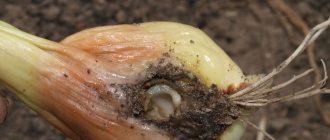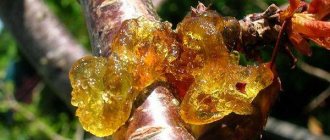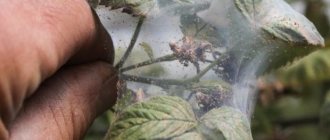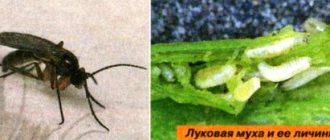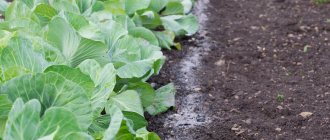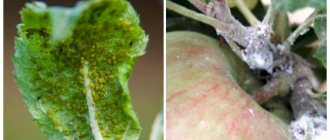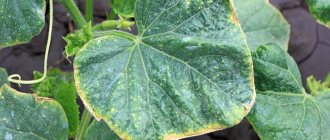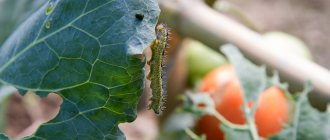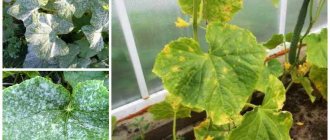Description of the disease and pathogen
Clubroot is one of the most dangerous and common diseases. Almost every farmer is familiar with “disfigured” plant roots. The causative agent is the lower fungus Plasmodiophora brassicae.
It develops only inside living crops and is stored in the form of spores in the soil for the winter. In the spring, zoospores are formed from them - this is a stage in the life cycle of algae and a number of lower fungi. With the help of flagella, the zoospore moves in a liquid medium into the plant through the hair roots. Infected cells increase in volume and proliferate very quickly.
A plant can become sick with clubroot at any time during the growing season.
Kilot-resistant cabbage varieties
When growing vegetable crops in your garden plot, it is recommended to give preference to resistant varieties with high immune protection. If cabbage cancer was found on the site, for the next season it is worth purchasing the following varieties of white cabbage: Nadezhda, Kilagerb F1, Ramkila F1, Zimnyaya Gribovskaya, Kilaton F1, Moskovskaya late 9, Ladozhskaya, Taininskaya. In addition, resistant varieties of Chinese cabbage and cauliflower have been developed: Lateman, Suprin, Clapton and Clarifry.
Attention! As a rule, the most resistant varieties are mid-ripening and late-ripening species.
Signs of the disease
In some cases, at the initial stage, the disease does not affect the appearance of cabbage in any way. The gardener, caring for the plantings, may not even realize that the crop has been infected. However, inspection of the root system puts everything in its place.
On the roots of young bushes you can see various growths and swellings with the naked eye. They block the absorption ability of the roots, so the absorption of water and minerals by plants is disrupted. On the roots of healthy seedlings, growths appear on the lateral roots in the form of icicles and small beads.
With severe and early infection with clubroot, cabbage seedlings are stunted in growth and their leaves turn yellow. Sick plants are unsuitable for further cultivation, since they take root poorly, the head does not form at all or is not fully formed, that is, it is impossible to obtain a good harvest suitable for further long-term storage.
One of the main signs of cabbage being affected by clubroot is the wilting of the lower leaves in hot weather.
Causes
The multiplication of the parasite is facilitated by increased soil humidity of 75–90% and high air temperature in the range of 18–24°C, as well as acidic soils. The fungus lives in the top layer of the earth and moves well in moist soil, irrigation, snow and rain water.
The infection can spread through gardening tools, human shoes and soil pests. The disease is not transmitted through seeds or air. Clubroot often gets into a garden plot when planting infected seedlings.
There is a high probability of infection when growing cruciferous crops in one place for several years in a row. This leads to a loss of more than 50% of the crop. The fungal spores do not die in the soil during wintering and remain viable for 4 years or more.
Factors provoking the disease
The source of infection is usually the soil in which the fungal spores live. They can maintain their viability for a very long time - 6 or more years. In addition, spores are well preserved in compost, so putting plants infected with a parasitic fungus into it is strictly prohibited.
The pathogen, which entered the soil from decomposed plants, can be spread throughout the entire area with the help of water, soil insects and earthworms. Clubroot is introduced into uninfected areas mainly with diseased seedlings. Weeds can also be a source of infection.
The development of clubroot is favored by the following climatic conditions:
- air temperature 18-25°C heat;
- ambient humidity 75-90%;
- soil acidity is 5.6-6.5, that is, acidic and slightly acidic soils; in a neutral environment, the activity of the pathogen decreases, and in an alkaline environment (pH greater than 7.0) it dies.
Most often, this disease is recorded in the Non-Black Earth Region, the soils of which are characterized by high humidity and acidity. It is a frequent visitor to heavy and wet soils.
However, overdried soil also contributes to the awakening of microorganisms, as well as depleted soil, which has a lack of calcium and potassium, as well as microelements - boron, zinc and chlorine, humus.
As soon as soil infestation with clubroot is detected, the area is “sent” to quarantine, which can last for several years.
Favorable conditions for the pathogen
One of the reasons why clubroot forms on cabbage is the presence of favorable conditions for its development. Natural conditions conducive to the development of the disease are heavy and acidic soils.
Such soils are difficult to clean after infection, and for safe planting of cabbage it is recommended to avoid planting cruciferous crops for at least 7-8 years.
Weather conditions are also an important factor contributing to the development of the disease:
- moderate air temperature from +18 to +25 degrees;
- air humidity 75-90%;
- increased soil acidity and neutral or slightly acidic groundwater.
In an uninfected area, under favorable conditions, clubroot can develop from 1-2 seedling plants infected during germination.
Fighting methods
Dormant spores of the parasitic fungus live in the soil for up to 7 years, but if host plants are not planted on the site, their viability decreases every year. Therefore, one of the effective methods of combating this disease is crop rotation, but folk remedies, as well as chemicals, are also used.
Crop rotation
Plants are planted in the area with clubroot that are not only resistant to it, but also accelerate the death of the fungus.
“Pills” for clubroot are:
- All plants of the nightshade family - tomatoes, potatoes, eggplant, peppers, aromatic tobacco, hybrid petunias and others. They will cure the earth of a pathogenic microorganism in 3 years.
- Crops of the goosefoot family - beets, spinach, chard. The last two families will help clear the land of spores even faster - in 2 years.
- Representatives of the lily family include onions, garlic, lilies, hyacinths and others.
The best therapeutic effect was shown by mixed plantings of tomato and spring garlic. In this case, the soil becomes healthier in 1 season. Next spring, to be on the safe side, beets are planted in this bed.
Folk remedies
If cabbage gets sick in adulthood, you can try to save the crop using folk remedies. But, it should be remembered that it will not be possible to completely cure clubroot this season. Apply:
- Infusion of wood ash. At the first signs, all withered, yellowed leaves are torn off, and the bush is watered with an infusion of wood ash - 10 glasses of the substance are poured into 10 liters of water and left for 2 days. Then 1 liter of infusion is poured into a bucket of water, stirred and 500 ml is poured under each bush. Water the plants after the main watering. Next, the cabbage is hilled higher - this promotes additional root growth in the upper part of the stem.
- Organic. Once every 7 days, organic fertilizers are applied to the plants - mullein, vermicompost, compost, yeast. They help curb the activity of the fungus and its spread.
- Tops. After harvesting, crushed beet and quinoa tops are spread on the site, a large amount of organic matter is added and the soil is dug up.
- Mortar. Infected beds are also watered with lime mortar - 150 g of lime is dissolved in 5 liters of water. 500 ml of the prepared solution is poured under each bush. After this procedure, the pH of the soil will increase and it will become alkaline.
If clubroot manifests itself at the last stage of development, then all heads of cabbage are removed and the soil is immediately treated.
Chemical and biological drugs
This pathogen is resistant to most antifungal drugs. But experimentally, several drugs have been found that really help inhibit the growth and development of the fungus. This:
- Trichodermin;
- Previkur;
- Glyocladin;
- Topaz;
- Fitosporin-M;
- Alirin B;
- Fundazol.
However, no drug can destroy the parasitic fungus and cure cabbage; they only inhibit the development of the fungus and prevent its reproduction.
HOW TO CLEAN YOUR GARDEN OF CABBAGE
Anyone who buys cabbage seedlings externally sooner or later introduces clubroot into their garden - the most common and most harmful disease of cabbage crops.
WHAT IS THE DANGEROUS KILA? At risk group Clubroot is transmitted mainly through the soil. The causative agent of the disease is the fungus Plasmodiophora brassicae. It affects all varieties of cabbage, other cabbage crops (radish, radish, daikon, turnip, rutabaga, watercress, mustard), as well as weeds of the same family (colc, wild radish, field mustard, shepherd's purse, spring grass, etc.) . Cauliflower and early white cabbage, as well as many high-yielding hybrids of Dutch selection, are especially sensitive to clubroot, regardless of ripening time. Clubroot infection occurs throughout the entire growing season. The earlier it happened and the more massive it is, the more damage will be caused to the crop. In case of severe damage, cauliflower heads may not form at all, while white cabbage produces very small, loose heads. If you consider that cabbage crops make up almost a third of all vegetables grown in family gardens, you can imagine what a disaster clubroot is once brought onto the plot.
Symptoms of the lesion White thickenings (swellings, growths) of various shapes and sizes form on the roots of the affected plants. If the plants were infected at the seedling stage, large swellings form on the main roots. If healthy seedlings were planted on contaminated soil, then the clubroot looks different - small thickenings in the form of icicles and beads form on the lateral roots. By autumn, the growths turn brown, rot and collapse. At the same time, a huge number of spores (cysts) enter the soil, which remain viable for 6–7 years. Any plant from the cabbage family that ends up on contaminated soil will provoke the germination of spores with its root secretions. The resulting mycelium, growing towards the roots, infects the sensitive plant, penetrating the root through the root hairs.
HOW TO PREVENT THE SPREAD OF CLOAK DURING PRIMARY INFECTION The first appearance of clubroot in a previously clean garden is always associated with diseased seedlings or the planting of a plant taken from an infected area. Clubroot, introduced into at least one bed, as a rule, quickly spreads throughout the entire garden and remains there forever. But the technology of narrow ridges gives a real chance to localize the disease with subsequent rapid and complete cleansing of the pathogen from the soil. Pesticides are not used. What should you do if clubroot is found on one of the narrow ridges while harvesting cabbage? • Collect, if possible, all the infected roots, dry them and burn them on a sheet of iron, after dousing them with gasoline. • Select a separate gardening tool for working in the contaminated garden bed, and wear rubber boots and gloves. • Do not walk around the entire garden until the work of collecting roots is completed and you have changed your shoes. • Work beet tops into the soil in the fall. After harvesting the beets, chop the tops, treat them with any preparation of “effective microorganisms” (for example, the preparation “Siyanie-1”) and dig with contaminated soil to a depth of no more than 10 cm.
Burn diseased roots over a bright, smokeless flame. A low-burning, smoking fire promotes the spread of the disease because viable clubroot spores are dispersed with the smoke. Of course, it is impossible to remove all diseased roots from the ground, and there is no doubt that the soil in the garden bed is contaminated. But the more carefully all growths are collected, the less massive the infection will be. Narrow beds are separated by almost meter-long passages that are not dug up, i.e. There is no mechanical mixing of clean and acidified soil, which gives a good chance of localizing the source of the disease. In the following seasons, refrain from planting crops susceptible to clubroot not only in the infected bed, but also in neighboring ones, since earthworms, slugs and other soil organisms can carry the spores there.
To localize the source of infection, it is important that there are no weeds from the cabbage family in the bed, on the sides and in the aisles. Weed control technology, practiced on narrow beds, allows you to keep your garden perfectly clean (“The Real Owner,” No. 5, 2006). Once you have clubroot, do not deviate from the instructions and promptly destroy weeds sprouting from seeds, without wondering whether they belong to the cabbage family or not.
QUARANTINE IS NECESSARY, BUT IT DOES NOT SOLVE THE PROBLEM Although resting clubroot spores remain in the ground for 6 or more years, in the absence of a host plant, the number of viable spores decreases over the years. In order for the number of spores to steadily decrease, you should not sow radishes, radishes, daikon, turnips, watercress, salad mustard, not to mention all varieties of cabbage, on contaminated soil. The presence of clubroot spores is not dangerous for plants that belong to other families, and from this point of view, any other vegetables can be cultivated in an infected bed. This is the tactic that experts recommend following. Give preference to leafy or fruit-bearing vegetables and avoid root vegetables, so that when harvesting you do not spread contaminated soil along with the root crops throughout the area.
Quarantine measures are necessary, but they do not guarantee that the source of infection will be localized and the soil will be cured. The persistence of a viable pathogen in the soil for many years increases the chance of infection spreading, despite all precautions.
SOIL TREATMENT To quickly eradicate the source of infection, I recommend a specially developed method of soil treatment, based on the observation that some vegetable crops are not only resistant to clubroot, but when cultivated in contaminated soil they cause accelerated death of the pathogen. Medicinal plants include representatives of 3 botanical families - nightshade (tomatoes, potatoes, etc.), lily (onions and garlic) and goosefoot (beets, etc.). Solanaceous crops completely free the soil from clubroot spores in 3 years. Vegetables from the lily family (onions, especially hot varieties, winter and spring garlic) and from the goosefoot family (beets, chard, spinach) clean the soil even faster - in 2 years. Of the lilies, the least active crop is the leek, and it is best not to use it to quickly heal the soil. The effect of nightshade and lily crops is additive, i.e. when they are planted together, the therapeutic effects are summed up.
To cure the soil from clubroot, the pair “tomatoes - spring garlic” turned out to be the most effective. When growing tomatoes and spring garlic in a mixed planting (a row of tomatoes versus a row of garlic) in an infected bed, clearing the soil of viable clubroot spores is achieved in one season. To avoid accidents, you can extend the soil treatment for another year: next season you can sow, for example, 2 rows of beets in the garden bed.
The reason for such wonderful results in the fight against clubroot is not only the use of medicinal plants. To localize the primary source of infection and eliminate it, the technology of narrow beds itself is no less important, which allows: • to prevent the spread of infection through clubroot-sensitive weeds; • avoid mechanical mixing of contaminated and clean soil; • minimize the possibility of transfer of contaminated soil with water during rain and irrigation.
Test for the presence of clubroot spores Before returning cabbage crops to cured soil, check its cleanliness in the spring. Sow Chinese cabbage in the problem bed. Collect it little by little, digging up the plants with their roots, starting from the growth of the first true leaves until the formation of a head of cabbage. The complete absence of growth on the roots during the entire growth period will indicate that the soil treatment was successful. The appearance of at least one white “bead” on the peripheral roots will indicate that soil treatment needs to be extended for another year.
AGRICULTURAL TECHNIQUES AFTER SOIL TREATMENT On soil freed from clubroot spores using medicinal plants, soil conditions that favor the development of the disease should be avoided. The defeat of cabbage crops by clubroot is promoted by: • calcium and potassium deficiency; • deficiency of microelements – zinc, boron and chlorine; • low (less than 2.5%) humus content in the soil; • waterlogging and drying out of the soil; • acidic soil environment (Kingroot spores germinate only in an acidic environment, they are especially active in slightly acidic, waterlogged soil; in a neutral soil environment their ability to germinate is reduced, and in a slightly alkaline environment (pH 7.2) it completely disappears). It is especially important to carry out the recommended agrotechnical measures when planting cabbage crops for the first time on cured soil.
Adding organic matter Before digging, add any organic matter in the amount of 2-3 buckets per linear meter of the ridge (compost, manure or pine humus). In the absence of organic matter, the planted plants need to be watered with a solution of peat humate (watering 4 times at weekly intervals).
Applying lime In central Russia, soils are usually acidic or slightly acidic, so liming is a mandatory agrotechnical practice. Gardeners are well aware of the standard recommendation - to lime the soil every 4-5 years. But the limed soil soon acidifies again, which is facilitated by rain, melt water, and the application of mineral and organic fertilizers. To maintain the reaction of the soil environment at a level close to neutral, not periodic, but constantly repeated application of lime is required. This is exactly what Mitlider technology provides. On narrow ridges, lime with a microadditive of boron (mixture 1) is applied for each planted crop (“The Real Owner,” No. 3, 2006). In the first year of planting cabbage on treated soil, the dose of mixture 1 should be increased: • 150 g per linear meter of ridge on sandy soil; • 200–250 g/m on mineral soil; • 250–300 g/m on peat bogs and heavy clay soils; • 300 g/m in lowlands with close groundwater.
Requirements for feeding mixtures The plants are fed with mixtures 2, the preparation of which is described earlier (“The Real Owner”, No. 4, 2006). Mixtures 2 used on soil treated for clubroot have some features: • only mixtures containing calcium nitrate are suitable; • the mixture must necessarily include some kind of chlorine-containing fertilizer, for example, potassium chloride; chlorine-free mixtures 2 are not suitable; • an increased dose of boron is added to mixture 2: 30 g of boric acid or 50 g of borax per full dose (7–9 kg of mixture).
Microelements Cabbage crops are sprayed twice with a solution of a complex preparation of microelements. The first spraying is carried out 1.5–2 weeks after planting the seedlings, the second – 3–4 weeks later. Instead of a complex preparation, you can spray with a 0.05% solution of zinc sulfate (0.5 g of zinc sulfate/l of water).
Selecting a variety In the first year after returning cabbage to its old place, you should not plant cauliflower and early white cabbage, as well as other heavily affected cabbages. Choose clubroot-resistant varieties. Among the traditional domestic varieties, the mid-season varieties Losinoostrovskaya 8, Taininskaya are relatively resistant to clubroot infection, and the late varieties are Zimnyaya Gribovskaya 13, Moskovskaya late 15, Moskovskaya late 9.
Planting seedlings If seedlings are planted without a root ball, their roots should be rolled in limestone flour or dipped in clay-lime mash. In the latter case, the lime will stick better to the roots.
Requirements for watering On treated soil, watering should be moderate; neither overmoistening of the soil nor lack of moisture should be allowed. To create an optimal water regime, cover the soil surface with mulch of pine needles (which will also protect the cabbage from damage by naked slugs), and cover the entire bed with a breathable material such as lutrasil.
HOW TO KEEP AN AREA FREE FROM COLOROMA? In order to keep your site free from the clubroot pathogen from year to year, make it a rule to never deviate from the proposed 3-year therapeutic and preventive crop rotation (see table). In the garden bed before and after cabbage crops, grow any vegetables belonging to the nightshade, lily and goosefoot families. To organize crop rotation, you will need to keep a diary. Each bed must have its own number and its own recorded long-term history (alternation of crops, appearance of a particular disease). Annual plantings are planned based on these records.
In the season preceding the planting of cabbage crops, and in the season following the cabbage crops, only those vegetables are grown in the beds that specifically affect the pathogen, causing its accelerated death. For the 4th year, you can grow any vegetables in the beds, including cabbage. But then in the 5th year medicinal cultures are used again.
Cabbages should always be preceded and followed by the vegetables listed in the table.
WHAT TO DO IF KILA HAS LIVED IN THE VEGETABLE SINCE IMMEMORABLE TIMES? In old garden plots, very often the entire soil is contaminated with clubroot. Moreover, the infection is maintained from year to year by the cultivation of cabbage, radishes, and other cabbage crops, as well as weeds susceptible to clubroot. It is not easy to clean such land, and it is better to carry out treatment in stages. Throughout the entire area, it is necessary to stop the reproduction of the pathogen and at the same time, step by step, conquer the territory from the clubroot, gradually expanding the boundaries of the clean land.
If the farm has a separate potato field, then the task is simplified - swap the positions of the vegetable garden and the potato field. In the absence of clubroot-sensitive weeds, it will take 3 years for potatoes to heal the land. It is necessary to cultivate potatoes on narrow ridges (without hilling), since with traditional cultivation of potatoes in ridges, weed control is difficult and the required cleanliness of plantings is hardly achievable. After treatment, test the soil for the presence of the pathogen, and then work on the cleaned land with the obligatory use of therapeutic and preventive crop rotation and compliance with recommended agricultural practices.
If the potato option does not work, the following measures will help bring the infection under control: • exclude all cabbage crops from the crop rotation for 2 years; • prevent weeds from growing in both beds and walkways; • clean the soil of the pathogen by planting crops included in the therapeutic and preventive crop rotation; • give preference to mixed plantings of nightshade crops with onions or garlic, alternating them with beets and other goosefoot crops; • do not disperse medicinal plants throughout the entire area of the garden, but cultivate them in adjacent beds, compactly; • Having cleared the first area, promote medicinal plantings to neighboring beds.
Test the results of treatment and be sure to record the data in a diary, where you also record fruit change, the addition of organic matter, soil treatment with EM (agronomically useful microorganisms), etc. To cure the soil of clubroot, such records are vital.
T.Yu. Ugarova, Doctor of Biological Sciences
Clubroot spore test
Experts recommend testing for the presence of fungal spores before returning cabbage to the beds. To do this, in the spring the area is sown with fast-growing Chinese cabbage. Throughout the growing season, it is gradually dug up along with the root system, and all roots are carefully examined.
Young plants that have grown their first true leaves begin to be dug up until heads form. If there are no thickenings or growths on any of the roots, then the soil has been successfully treated and cruciferous plants can be planted on it without fear.
The appearance of even one “icicle” on the roots signals the presence of spores in the soil; treatment must be extended for another year.
What to do after treating clubroot
To prevent the spread of disease:
- do not plant cruciferous crops in this area; planting is done after testing the soil;
- carry out preventive work to prevent the spread of the disease;
- If possible, plant crops in this area for several seasons that are not susceptible to this disease.
Preventive actions
In order not to waste time and effort on treating this dangerous disease, they adhere to some preventive rules.
Kill-resistant varieties of white cabbage
Cabbage varieties resistant to the disease are presented in the table:
| Name | Ripening period | Growing region | Head weight, kg |
| Kilagherb | mid-season | Northwestern, Central | 2,4-3,0 |
| Kilagreg | early ripening | Northwestern, Central, Volga-Vyatka, Central Black Earth, Ural, West Siberian | 1,7-2,5 |
| Kilaton | late-ripening | Northwestern, Central, Volgo-Vyatka | 1,9-3,0 |
| Hope | mid-season | all except the Northern and North Caucasian districts | 2,4-3,4 |
| Ramkila | late-ripening | Central | 2,0-2,7 |
| Tequila | mid-season | Northern, Central, Volga-Vyatka, North Caucasus, Ural, West Siberian, Far Eastern | 2,3-3,0 |
Cabbage Kilagherb
Cabbage Kilagreg
Cabbage Kilaton
Cabbage Nadezhda
Ramkila cabbage
Cabbage Tequila
Pre-sowing preparation of seeds and soil and what to add to the hole before planting
Before sowing, seeds are treated in several ways:
- soak them in hot water (50°C) for 20 minutes, the water should not cool; then the seed material is cooled and well dried;
- or leave the seeds in a 1.5% mustard solution for 6 hours.
A week before planting seedlings in a permanent place, the soil is treated with a solution prepared from 300 g of copper sulfate, 300 g of slaked lime and 8 liters of water or treated with a 0.1% solution of Fundazol.
The roots of seedlings, before transplanting to a permanent place, are kept for 2 hours in a solution of Fitosporin-M or treated in a suspension of sulfur-containing preparations - colloidal sulfur, Thiovit Jet, Cumulus DF.
When planting without an earthen ball, the roots of the seedlings are rolled in lime flour or dipped in lime-clay mash. The second option is preferable, since lime attaches well to the roots.
Weeds are removed in a timely manner, especially representatives of the cruciferous family - shepherd's purse, rapeseed, spring grass, and field mustard. The roots of these plants are an excellent refuge for spores in winter.
It is recommended to add 1 handful of wood ash or ash to the hole before planting cabbage.
Healthy seedlings
Clubroot is not transmitted through planting material, but you need to remember: in the future, adult plants may not be affected by clubroot if vegetable growers have grown strong and healthy seedlings.
And the key to healthy seedlings is pre-sowing treatment of seed material as follows:
- heat treatment of seeds
. At the same time, they are immersed in water with a temperature of up to 50 degrees Celsius for 1/3 of an hour. But it is very important that the water temperature is not higher than the specified limit, otherwise the seed material will overheat and lose germination. And if the ode is colder, then there will be no positive effect from such a procedure; - seed material is placed in a 1.5% solution of mustard powder for ¼ day;
- seeds must be kept in a solution of any growth regulator
(for example, Epin). After this procedure, the germination of the seed material increases, it will germinate faster, and the immunity of adult plants to diseases will increase; - seed material can be placed in a solution of ascorbic acid
(0.2 g of the drug per 2 liters of water) for 18 hours. After such treatment, the seedlings grow stronger, and their root system becomes more powerful.
After each such procedure, the seeds should be washed with running water.
Clubroot on cabbage, a dangerous fungal disease, control measures
Advice from gardeners
Experienced gardeners know how to fight fungal disease and protect their crops from it forever:
- for preventive purposes, marigolds, spinach and calendula are planted next to cabbage;
- water the seedlings with lime milk (80 g of the substance is stirred in 1 liter of water) 2-3 days before transplanting them into open ground;
- Before planting seedlings, add 1 dessert spoon of calcium nitrate to each hole and mix it with the soil;
- Cabbage is grown in narrow beds, which makes it possible to localize the disease if necessary and quickly clear the soil of the pathogen.
Clubroot is a dangerous fungal disease that can completely leave a gardener without a vegetable harvest. Timely fight against the disease and compliance with preventive measures will help you cope with it and forget about its existence forever.
0
0
Copy link
Prevention
To maintain a healthy plot, we must not forget about the three-year procedure of preventive crop rotation. Preventive measures to prevent cabbage clubroot are accompanied by planting plants that destroy fungal spores. Before and after growing cabbage, as well as other cruciferous crops, it is recommended to plant plants from the madder, lily and nightshade families. A year before planting cabbage, tomatoes, onions, beets or garlic should be planted in the garden bed. In the fall, after harvesting cabbage roots from the beds, it is important to dig up the area with beet tops. You should also promptly destroy weeds on the site.
Previous
CabbageDescription and lifespan of the cabbage butterfly
Next
CabbageHow to properly hill up cabbage after planting in open ground
How to check the soil for clubroot infestation?
We have already discussed the point that after clubroot disease is detected, cabbage cannot be planted in this area for one, or better yet, two seasons. When the time to plant seedlings has finally come, do not rush without checking the soil for the presence of fungal residues. Experienced gardeners advise testing the soil. Ordinary gardeners will not use special laboratory methods; firstly, it is expensive, and secondly, it is unprofitable.
Only soil that was contaminated last season is tested. How to do it?
- It is necessary to plant a small amount of Chinese cabbage in the test soil.
- An initial check for fungus should be carried out when the plant wilts or new leaves appear.
- The next check should not be earlier than the head of cabbage begins to form.
The soil needs to be checked for fungal residues by planting Chinese cabbage
If, on the contrary, the “experimental” plant behaved as healthy throughout the entire period before harvest and produced a good harvest, then you have completely gotten rid of the pest. Do not forget that even the smallest growth is a signal that the fungal pathogen is alive and ready to ruin your harvest.
Factors that contribute to the development of fungus
Conditions that may cause the development of a microorganism on the site:
- increased soil acidity;
- adding fresh manure;
- presence of plant residues of infected crops;
- non-compliance with crop rotation;
- violation of care requirements: excessive watering, neglect of loosening.
Clubroot mainly enters the garden through purchased seedlings, so before purchasing, inspect the roots for seals.
Determination of soil contamination
Before planting white cabbage and other members of the Cruciferous family, it is necessary to test the soil for the presence of spores of a parasitic fungus. The test is carried out by planting Chinese cabbage on a selected area, which has a fast ripening period. Dig up the plant at different stages of development and carefully examine the roots. The presence of growths means that there are spores in the soil and before planting other crops it is better to disinfect the soil and re-test.
